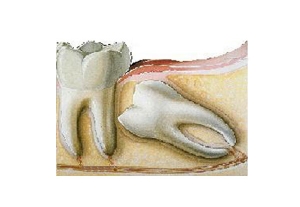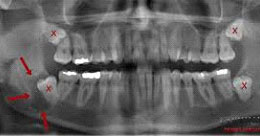Wisdom tooth extraction

Wisdom teeth approximately erupt at the age of 18-20 years in mandibular and maxillary jaws.
Why do wisdom teeth need to be extracted?
Partially erupted wisdom tooth remains covered by the gums and predispose soft tissue inflammations, accompanied by pain, swelling and temperature. Inflammations recede several times per year.
Incorrectly erupted wisdom teeth (especially upper) can cause buccal trauma when chewing. Often the injury occurs unconsciously at night.
Orthodontic reasons:
- a) Wisdom teeth removal can create additional space needed for teeth straightening.
- b) Malpositioned wisdom teeth may cause crowding of teeth.
Wisdom teeth can cause root resorption or decay of neighboring teeth.
When endodontic treatment is needed, wisdom teeth extraction is recommended due to difficult reach, unpredictable canal anatomy and questionable outcome of the treatment.
When treating periodontitis wisdom teeth may be removed to stabilize clinical situation, alleviate pain and improve oral hygiene.
Of course, in the absence of any of these reasons, wisdom teeth removal is not necessary.
How wisdom teeth removal is different from the others? Incompletely erupted or impacted wisdom tooth extraction requires a lot of specific knowledge and high competence. This should be done only by an experienced oral surgeon!!!
- Impacted upper wisdom teeth are usually extracted quickly and easily. Healing period is rarely painful.
- Before the removal of lower wisdom tooth, dental or panoramic X-ray is needed to assess the configuration of roots. This determines the risk, tactics and speed of extraction.
X-ray photos:


Under a local anesthesia, small incision is made and then, depending of the situation:
- Whole tooth is removed at once.
- Bone covering tooth crown is reduced using laser or drills and then the tooth is removed.
- Bone covering tooth crown is reduced using laser or drills, tooth is separated into two parts and then removed.
Treatment usually takes 10-30 minutes. The wound is sutured with absorbable thread, swab is placed for half an hour and postoperative regime is explained.
How to behave and what to expect after mental tooth extraction
As already mentioned, problems are rare after impacted upper wisdom tooth removal. Swelling or pain is usually absent or lasts for several days. After impacted lower wisdom tooth extraction buccal swelling can be observed for 2-3 days. The pain depending on the complexity of extraction and compliance with regime lasts for 1 to 10 days.
To avoid pain during postoperative period we recommend:
- Applying cold on the cheek on the day of extraction
- Using antibiotics as prescribed
- Following the regime (do not eat for 2 hours, do not drink hot beverages, etc.)
Complications after wisdom teeth extraction:
- High temperature, accompanying buccal swelling and difficulty in mouth opening, after lower wisdom tooth extraction, if it lasts more than one day. Considered to be a rare complication, if patients use antibiotics as prescribed by doctor.
- The lower lip numbness. Inferior alveolar nerve, which serves sensory receptors in the lower lip, passes through the lower wisdom tooth roots. While extracting the tooth, its roots can touch the nerve, which is enough to cause numbness. Generally it is a reversible process. A probability of numbness is 0.2%. Clinician’s experience and skills play a key role. The lower alveolar nerve is anatomically close to all of the lower wisdom tooth in every clinical situation. Therefore, the argument not to remove wisdom tooth because it lies near the alveolar nerve is invalid. If, however, numbness of the lip occurred, do not expect it to go away in a few days. Usually numbness lasts a month or longer. But most importantly it always passes!!!
- Bleeding after extraction. Sometimes it occurs even if dentist’s recommendations were precisely kept. In such case, insert and bite a sterile bandage in the extracted tooth area. Keep it bitten for about half an hour. Apply some cold on the cheek. If bleeding persists, contact your dentist.
- One-sided tongue numbness. A rare complication which is most commonly associated with anesthesia. Lingual nerve perforation can occur while injecting anesthetics into the lingual side of the tooth. In this case, numbness will last for a month or longer. Mechanical nerve injury during surgery is also possible, but every case should be assessed individually.
The main challenge of removing impacted lower wisdom tooth is to create an algorithm that would allow minimization of postoperative pain and discomfort. Thousands of complex impacted wisdom tooth extractions have been performed in our clinic. The main factors most heavily influencing the postoperative pain are respectively:
- Neglectingto finish a prescribed course of
- Absence of blood clot.
- Speed of extraction.
- Traumatism of extraction.
- Wound suturing.
A PRF (Platelet Rich Fibrin) method is available in our clinic. After the tooth extraction, dental alveolus is filled with PRF, thereby reducing the risk of postoperative bleeding, infection, pain and facilitating healing. Find out more about PRF in technologies section. Laser stimulation of post-extraction dental alveolus is also a very effective postoperative pain prevention measure.




